 |
 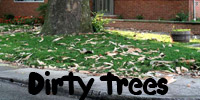  |
Welcome to bobklips.com, the website of Bob Klips, a plant enthusiast living in Columbus, Ohio. June 6, 2008 Little Lookalike Legumes Marion, Ohio There are several clovers and clover relatives that have small heads of yellow flowers. These are members of the pea or legume family, Fabaceae, that have individually small flowers arranged in heads (or umbels that look like heads because the flower stalks are very short). The leaves are trifoliolate, i.,e, each leaf is fully and completely divided into separate leaflets. The leaflets are often mistakenly referred to as leaves...the proverbial "4-leaved clover" is actually a 4-leaflet clover!  Two small members of the pea family, Plant genera with simlar
flowers are often differentiated by their fruits. Clovers in the strict
sense, i.e., members of the genus Trifolium, have flowers that
retain their petals into the fruiting stage, surrounding the small
legumes. This is evident in the fruiting heads of a largeclovers
such white clover (Trifolium repens).
June 3, 2008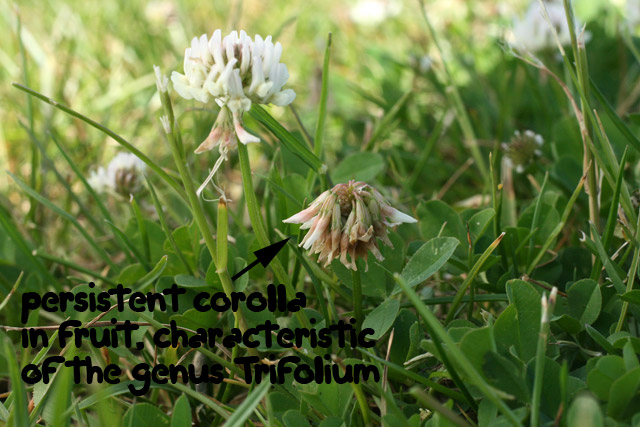 White clover in early fruit stage, OSU at Marion, OH, June 6, 2008 . Only one of the lookalike legumes shown above is a true clover in the genus Trifolium. On the left, it's the smaller species with fewer flowers, one of the hop-clovers, T. dubium. They're called hop-clovers because, when in fuit, they resemble clusters of hops (the beer-flavoring agent).
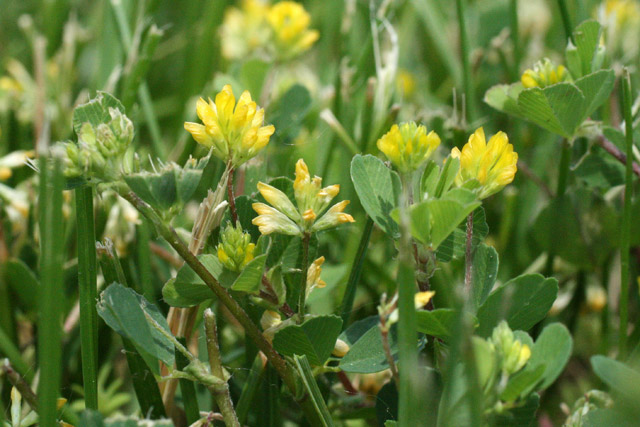 Little hop-clover (Trifolium dubium), OSU at Marion, June 6, 2008. It's interesting to note that although clovers are widespread and familiar, there's only one native clover in Ohio (the extremely rare buffalo clover, T. stoloniferum). Here is a list of Ohio clovers from the spreadsheet generously provided by the Ohio EPA as part of their "Floristic
Quality Assessment Index (FQAI) for Vascular Plants and Mosses for the
State of Ohio," by Barbara Andreas, John Mack and James McCormac, 2004,
Ohio Environmental Protection Agency. Names in UPPER CASE are introduced species.
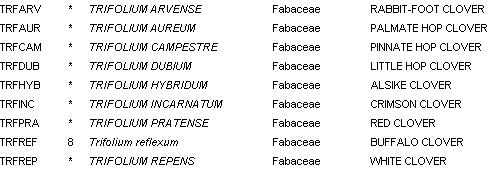 Clovers of Ohio, all but one are aliens! On the right in the figure above is a little yellow clover-like thing that isn't a clover at all. It's black medick, Medicago lupulina. In Medicago,
the petals fall off after flowering and the little legumes are thus
directly visible. They eventually turn black, which I guess is why a
yellow-flowered plant is called black medick.
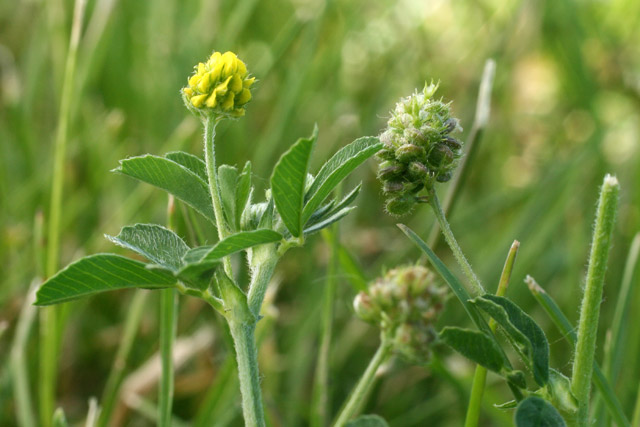 Black medick (Medicago lupulina), OSU-Marion, June 6, 2008. Surprisingly, because it has purple flowers and looks so different, Ohio's other Medicago is alfalfa, M. sativa.
 Alfalfa (Medicago sativa), Columbus OH, June 7, 2008. "An Invasive Meltdown" (Excellent Columbus Dispatch article on invasive plant research) Today's Columbus Dispatch has a terrific article by Spencer Hunt focusing on a study by the U.S. Forest Service and OSU Plant Ecologists. The heart of the problem is the emerald ash ash borer that has caused the deaths of ash trees in the midwest. The tree loss creates sunny patches that might help invasive plants in a sort of "chain reaction" of vegetation disruption. The researchers are studying these effects at 155 research plots in Ohio and Michigan. The article has some very good pictures by Tom Baker of the Dispatch, but unfortunately they had to be rather small in order to fit into the narrow newspaper columns. Here from my photo archives are the three invasive species profiled in the article. The italicized captions are direct quotations from the profiles (Spencer Hunt, "Invasive Meltdown," Columbus Dispatch, June 3, 2006, page A7). 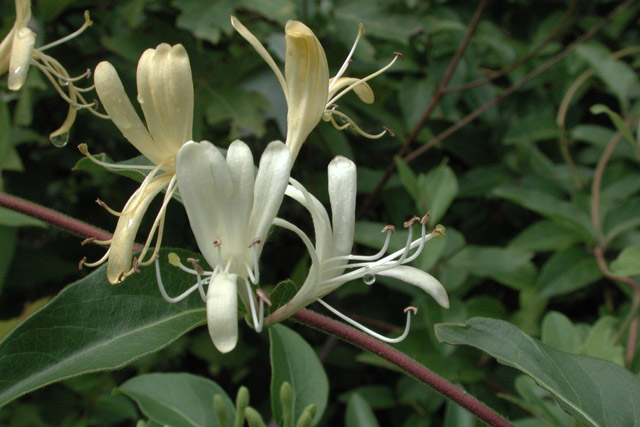 Japanese honeysuckle (Lonicera japonica). (August 30, 2003, Stages Pond State Nature Preserve, Pickaway County, OH). "A vine that can grow when native plants are dormant; smothers most native plants in its path"  Autum olive (Eleagnus umbellata) (May 5, 2006, along Rte 315, Delaware, OH) "Brought to the U.S. from Asia in the 1830s; grows quickly and can trap nitrogen that other plants need."  Garlic mustard (Alliaria petiolata) (May 6, 2008, Pleasant Township Park, Marion County, OH) "Brought to America by European settlers; produces many seeds and crowds out native plants." The fear is that the invasive plants will
eliminate shade-tolerant native species. The four native plants that
are mentioned as being vulnerable are wild geranium, wild ginger,
Virginia creeper, and sensitive fern.
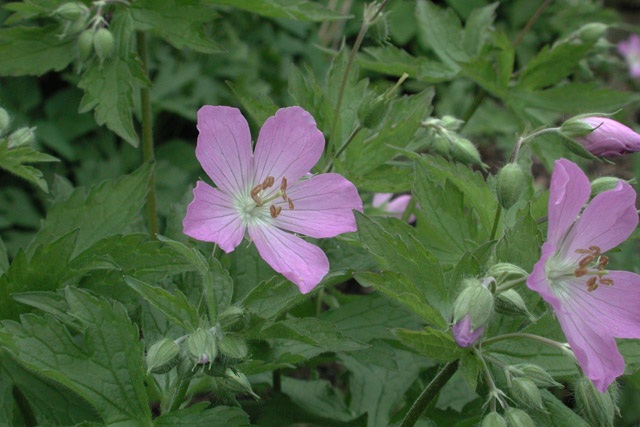 Wild geranium (Geranium maculatum) (May 3, 2003, Terradise Nature Preserve, Marion County, OH). This species has a ballistic seed dispersal mechanism wherein the fruits, when dry and mature, split lengthwise abruptly and fling the seeds away from the parent plant  Wild ginger (Asarum canadense) (May 5, 2005, Delaware Wildlife Area, Marion County, OH) Not related to the ginger spice of commerce, but very similar in fragrance. 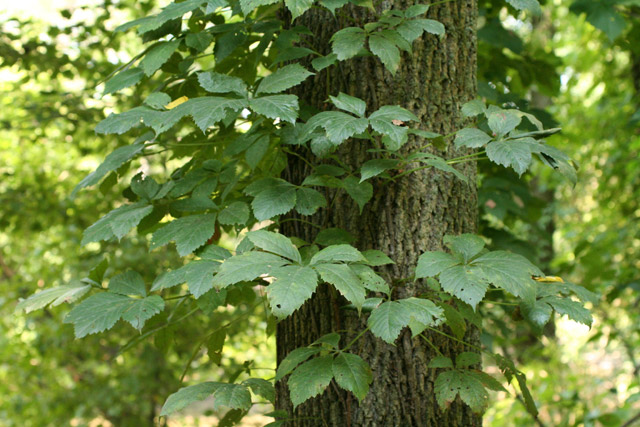 Virginia creeper (Parthenocissus quinquefolia) (September 8, 2005, Caledonia Nature Preserve, Marion County, OH) Often growing alongside poison ivy, distinguishable from it by having five leaflets instead of poison ivy's three leaflets. 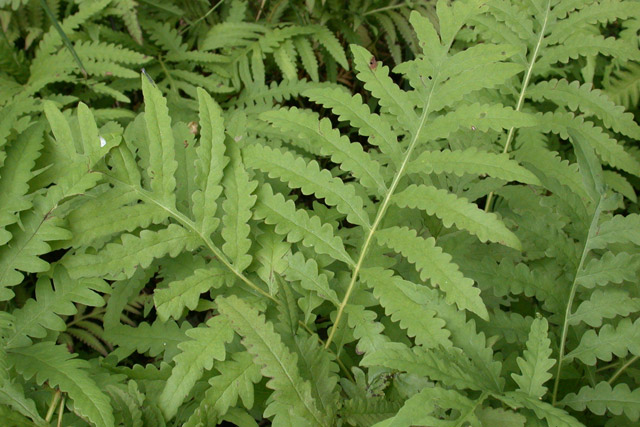 Sensitive fern (Onoclea sensibilis). (August 31, 2004, Stages Pond State Nature Preserve, Pickaway County, OH) Named for its sensitivity to frost. The "chain reaction" that the ecologists
are worried about is the detrimental effects that could cascade down
to the organisms (microbes, insects and other animals) that are
associated with the native plants. This is both a serious problem and
an intrtiguing area for research. Another great piece of science
reporting by our local paper, much appreciated!
June 2, 2008. A rose. There are 11 species of rose
growing wild in Ohio, of which five are native, six are alien. There is
a rose shrub flowering profusely at the edge of the woods at OSU's
outdoor plant research area, Waterman Lab, which is familiarly called
"Waterman Farm." A few days ago it seemed the petals of this rose
were more rose-colored than they are today, when they are almost
white. It turns out to be one of the introduced (escaped from
cultivation) ones, R. canina, the dog rose. How can you tell?
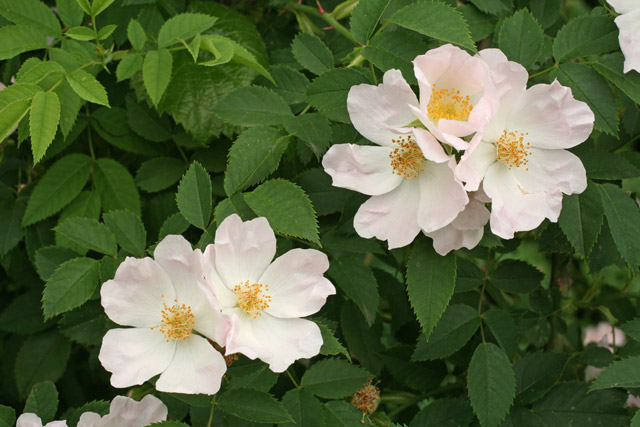 Dog rose (Rosa canina), Waterman Farm, Columbus OH, June 2, 2008. One of the features that sets apart groups
of roses has to do with the group of styles that emerges from the mouth
of the floral cup (hypanthium). In some species (not this one) the
styles extend out above the mouth for some distance as an elevated
projection, whereas in the group to which dog rose belongs, the styles
stop abuptly just above the mouth.
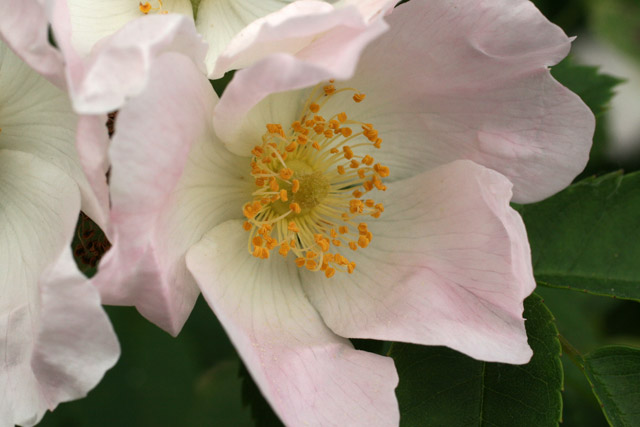 Dog rose (Rosa canina), Waterman Farm, Columbus, OH, June 2, 2008. A feature of the calyx (sepals, considered
collectively) is important too. In some species (not this one), all the
sepals are more or less the same, whereas in the group that dog rose
belongs to, the outermost sepals have narrow leaf-like side extensions.
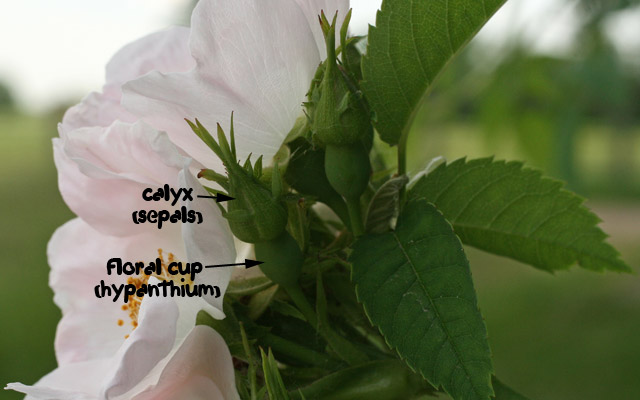 Dog rose (Rosa canina), Waterman Farm, Columbus, OH, June 2, 2008. Rose leaves are pinnately compound and
have prominent persistent stipules at the base of the leafstalk. The
stipules are of diagnostic value, as in some species (not this one)
they are hairy or have frilly edges. Dog rose stipules are
smooth-edged and hairless, and attached to the leafstalk for most of
their length.
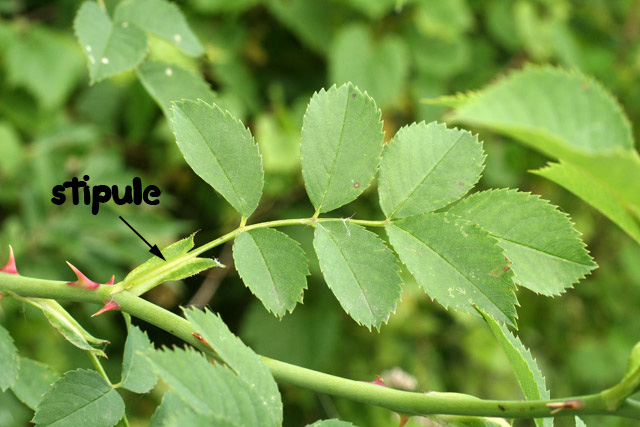 Rosa canina leaf, June 2, 2008, Waterman Farm, Columbus, OH. This bug (it really is a "bug," because
entomologists use that word in a scientific way in reference to a
member of the order Hemiptera) is a stinkbug. Stinkbugs are called that
because they give off a bad smell if they are crushed or handled
roughly. Is this one a plant-eating stinkbug or a predaceous stinkbug
that is waiting there to attack a pollinating insect?
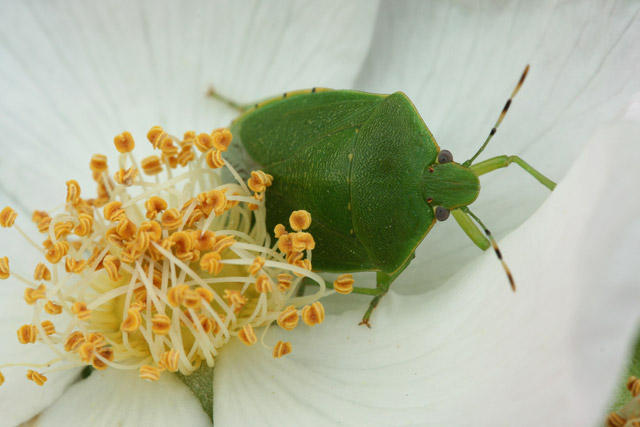 Stinkbug (Order Hemiptera, family Pentatomidae) on dog rose at Waterman Farm, June 2, 2008. May 30, 2008. OSU at Marion: Native Invasion --butterweed (Senecio glabellus) Last week (described below) I saw a striking display of a native perennial prairie herb, golden ragwort (Senecio aureus)
at the Larry R. Yoder Prairie on the OSU at Marion Campus. Of similar
aspect but strikingly different ecology, there's a comparatively new
weedy Senecio, S. glabellus, here in central Ohio.
It's called "butterweed," and it's unusual among aliens in that, unlike
most of our weeds which originated in faraway other continents like
Europe, Asia or Altantis, this one is native to southeastern
states of the good old U. S. of A! (A few other North American weeds
occur in Ohio, but most of them, such as wild 4-o-clock (Myrabilis nyctaginea) and western mugwort (Artemisia ludoviciana) are dry-site western species that spring up along railroad tracks, no doubt brought there by the trains.)
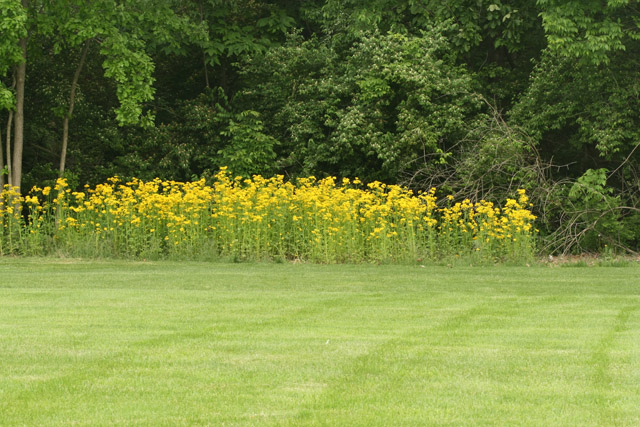 Butterweed (Senecio glabellus, family Asteraceae) at OSU-Marion, May 29, 2008. Presently this species is
blanketing many first-year
fallow corn or bean fields throughout the region, forming massive
swathes of golden yellow. It seems to be a relative newcomer here.
Neither I nor several plant-oriented people I've spoken with about
it recall having seen butterweed until 10-15 years ago, and they
agree it seems more and more prevalent every year.
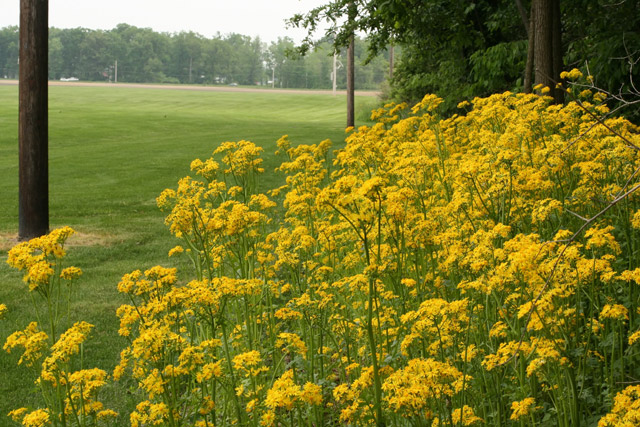 Butterweed (Senecio glabellus, family Asteraceae) at OSU-Marion, May 29, 2008. 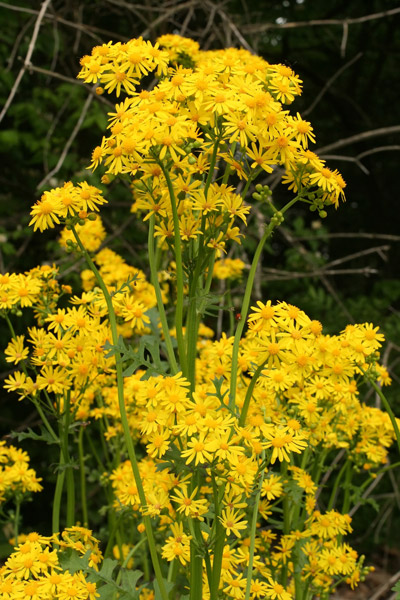 Butterweed (Senecio glabellus, family Asteraceae) at OSU-Marion, May 29, 2008. 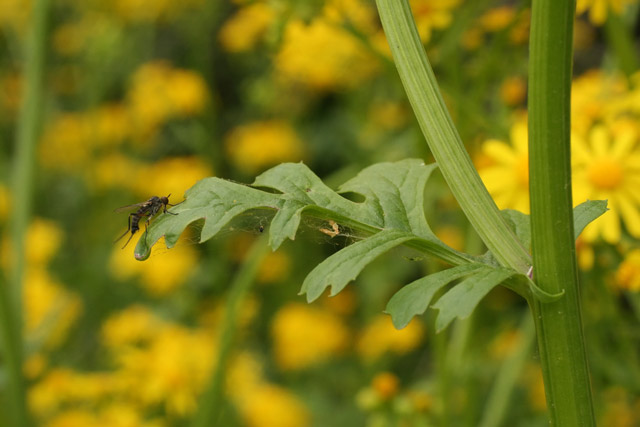 Portion of stem of butterweed (Senecio glabellus, family Asteraceae) at OSU-Marion, May 29, 2008. The stems are glabrous (hairless) and the leaves are deeply lobed.  Flower heads of butterweed (Senecio glabellus, family Asteraceae) at OSU-Marion, May 29, 2008. More recent observations ("back") |